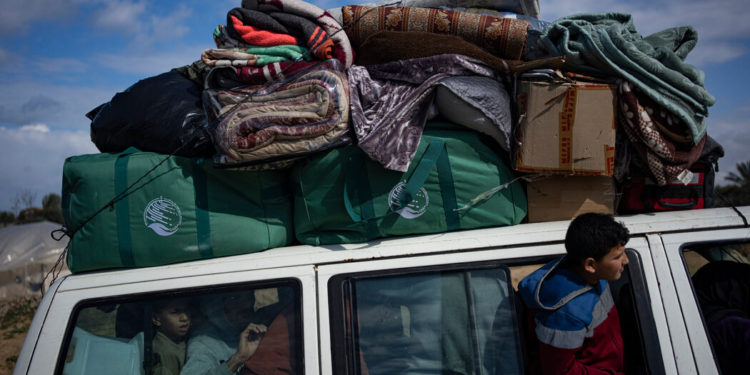By THE NEW YORK TIMES
Israeli forces pushed deeper into southern Gaza’s largest city on Wednesday, surrounding two major hospitals where thousands of people were seeking safety as a strike on a United Nations shelter killed at least nine people, according to U.N. officials and local health officials.
The Israeli military said it had “currently ruled out” that its aerial or artillery fire had been responsible for the strike on the shelter in Khan Younis, where the U.N. was housing about 800 people. In addition to the nine dead, 75 other people were injured, according to Thomas White, who helps oversee U.N. aid operations in Gaza.
U.N. officials did not directly blame Israel, but said the shelter, in a vocational training center, had been hit by two tank rounds. Israel is the only combatant in Gaza with tanks.
Philippe Lazzarini, the head of the U.N. Palestinian aid agency, said that the shelter was “clearly marked” as a U.N. facility and that its coordinates had been shared with the Israeli authorities. “Once again a blatant disregard of basic rules of war,” Mr. Lazzarini wrote on social media.
At a news conference in Washington, Vedant Patel, a State Department spokesman, called the strike “incredibly concerning” and added: “Civilians must be protected, and the protected nature of U.N. facilities must be respected.” He declined to say whether U.S. officials had spoken to the Israelis about the shelter strike.
The Israeli military said that it was conducting a review of its operations in the area of the shelter.
The Israeli military, which has described Khan Younis as a bastion of Hamas, the militant group that led the Oct. 7 attack on Israel, says its forces have encircled the city after weeks of heavy bombardment and gunfights. On Wednesday, Israeli soldiers were surrounding two major hospitals where thousands of Gazans were seeking safety.
In a statement, the Israeli military accused Hamas of exploiting the civilian population and said that its operation in Khan Younis would continue until it had finished “dismantling Hamas’s military framework and Hamas strongholds.”
Thousands of the civilians now in danger in Khan Younis had fled there to escape airstrikes and shelling in northern Gaza earlier in the war, packing into shelters and tents on the streets. No place in the city is safe, some say.
“Our last night in Khan Younis felt like doomsday,” one Gazan, Yafa Abu Aker, said on Wednesday morning after walking about five miles from a refugee camp in the city to Rafah, near the Egyptian border. That city, too, is packed with people who have been forced from their homes.
In Khan Younis, Ms. Abu Aker said, she and others sought refuge in areas that the Israeli military had designated as safe zones, only to witness violent clashes, military planes flying overhead, bombs falling, shelling from tanks and gunfire.
“If we had stayed,” she said, “we would have been buried under the rubble.”
On Tuesday, the Israeli military ordered evacuations from parts of the city that include two hospitals, Nasser, the largest in southern Gaza, and Al-Amal. They are among the last hospitals in Gaza still providing limited medical care.
Aid organizations and local officials said both hospitals were under siege. The Palestine Red Crescent Society, which runs Al-Amal, reported “intense shelling” nearby and said that a strike had killed three people outside its offices and in a nearby building. Israeli troops were “surrounding” Red Crescent workers and “enforcing restrictions on movement” around the group’s offices and the hospital, it said.
The Gaza Health Ministry said that Nasser Hospital had for all practical purposes been cut off by “continuous bombing,” preventing injured people from getting there and blocking the transfer of patients to a nearby Jordanian field hospital. The field hospital, too, was included in an evacuation area, the United Nations’ humanitarian affairs office said on Tuesday.
The three hospitals, with a total of more than 600 beds, account for a fifth of the remaining functional hospital capacity in Gaza, according to the U.N. It said the evacuation area held 88,000 residents and an estimated 425,000 displaced people, packed into about 1.5 square miles.
Doctors Without Borders, the aid group, said late Tuesday that its staff members at Nasser could hear bombs and heavy gunfire, and that 850 patients and thousands of people sheltering there were unable to leave because roads from the hospital were either inaccessible or too dangerous. The group said that it was “deeply concerned” for people’s safety.
The Israeli military has said that mortar fire was launched at its troops from the hospital. The claim could not be independently verified.
The strike on the shelter was only the latest to hit a U.N. facility. The organization says that 237 of its buildings have been hit in the war, including 150 belonging to its aid agency for Palestinians.
U.N. officials said the death toll from the strike on Wednesday was likely to rise.
Hanan Al-Reifi, who had been staying at the shelter, said that “many people” had been killed and wounded. She said that emergency services had not responded to calls for help and that people at the shelter did not have fire extinguishers.
The strike was likely to further stoke accusations that, despite pressure from the Biden administration and others, the Israeli military has not done enough to protect civilians in its campaign to crush Hamas.
Israel launched its offensive after Hamas led the Oct. 7 attack on southern Israel, killing about 1,200 people and seizing about 240 hostages, according to Israeli officials. Since then, more than 25,000 people have been killed in Gaza, local health officials say, and most of the territory’s 2.2 million people have been forced from their homes.
Reporting was contributed by Matthew Mpoke Bigg, Victoria Kim, Farnaz Fassihi and Anushka Patil.







Discussion about this post